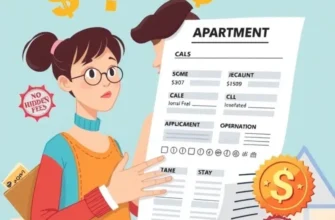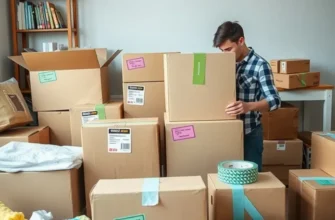Moving into your first rental can feel like a thrilling rollercoaster ride—unexpected twists, a few stomach drops, and, oh yes, that feeling of being totally lost at times. Among the whirlwind of packing boxes and selecting décor (because, of course, your taste is impeccable), comes the crucial task of organizing important documents. Whether you’re a fresh-out-of-college young professional, a couple seeking a cozy nest, or a bustling family gearing up for a new chapter, making sense of your paperwork can save you from unnecessary stress—and maybe even help you avoid the headache of a delayed lease signing! Knowing where your lease agreement, IDs, and change of address forms are can make you seem like you have it together (even if you’re frantically Googling the difference between a security deposit and first month’s rent). Let’s dive into some practical ways to organize those important documents so you can focus on what really matters: enjoying your new place, possibly with takeout and plenty of cozy blankets.
The Paperwork Puzzle: What You Need to Keep

Moving to a new place is an exciting adventure, but it comes with its own set of challenges, especially when it comes to organizing your essential documents. To make sure your transition is as smooth as possible, gathering and managing the right paperwork is critical. Here’s a comprehensive guide on what you need to keep handy.
First on your list should be the lease agreement. This crucial document lays out the terms and conditions of your tenancy. It includes details such as the duration of your lease, payment terms, and rules you must follow while living in the property. Having quick access to this document is necessary not only for disputes but also for understanding your rights as a tenant. Familiarize yourself with your financial obligations as a tenant to ensure you are prepared for any upcoming costs.
Next, you’ll want to secure proof of renters insurance. Many landlords require tenants to have renters insurance as a condition of the lease. This document provides evidence of coverage, protecting both your property and providing liability insurance in case of accidents within your space. Ensure your contract details the coverage limits and the types of damage covered.
The utility contracts are equally important. These documents confirm the transfer of services such as gas, electricity, internet, and water into your name. They often require activation fees, so it’s good to have them settled in advance. An organized system can help track these contracts’ term lengths and renewal dates, avoiding any service interruptions.
You should also keep a copy of your move-in condition report. This report outlines any existing damages or issues with the apartment at the time you take possession. It’s a critical document for protecting your security deposit at the end of your lease, as it helps avoid unfair charges for damages that existed before you moved in.
Additionally, create a folder for communication records with your landlord or property manager. Email exchanges, official letters, and submitted maintenance requests serve as proof of all interactions and are invaluable in the event of misunderstandings or disputes.
An often overlooked document set involves your personal identification documents. Keep copies of your ID, passport, and any relevant visa or work permits in a secure location. These are sometimes required by landlords or municipal services for verification.
To manage all this paperwork efficiently, adopt a categorization system. Use labeled folders or a digital tool where you can store scanned versions of each document. You can create broad categories like ‘Lease Documents’, ‘Utilities’, and ‘Insurance’ for easy retrieval. Be sure to back up digital copies on a secure cloud service to ensure you can access them from anywhere.
Organizing your moving documents might seem daunting, but with careful planning, it’s entirely manageable. By keeping these essential documents within easy reach, you’ll lay the groundwork for a more seamless and stress-free move.
Storage Solutions: Where to Keep It All

Organizing your important documents can mitigate the chaos of moving. Adopting a thoughtful approach to storage not only ensures accessibility but also protects against misplacement. Let’s explore some clever strategies for storing your crucial papers securely and conveniently.
Physical Folder Organization
When dealing with tangible documents like leases, IDs, and bank statements, a sturdy folder or binder is indispensable. Opt for a durable filing system that allows categorization. Label each section or tab for easy retrieval, such as Leases, Insurances, Personal IDs, and Receipts. Keep these folders in a dedicated drawer or a safe space, avoiding damp areas to prevent damage. For a touch of creativity, consider customizing these folders with colors that symbolize different categories, making it both functional and engaging.
Digital Backups
Digitizing your documents provides an accessible and space-saving solution. Scanning key paperwork and storing them as PDFs gives you quick access via your computer or mobile device. Utilize built-in encryption features to add an extra layer of security. Organize digital files into a folder structure mirroring your physical system, using clear labels for quick identification.
Cloud Storage Options
Cloud storage offers the convenience of accessing documents anywhere, anytime, with internet access. This is especially useful when moving between locations or if you need instant access to a lease during rental negotiations. Choose a reliable and secure cloud service that offers adequate storage space. Regularly update your files to reflect the most current versions and delete outdated documents to maintain clarity. By implementing auto-sync features, new changes to important documents are seamlessly updated.
Enhancing Security and Accessibility
Balancing security with accessibility is crucial. For documents containing sensitive information, enable two-factor authentication for digital and cloud storage accounts. Consider password-protecting files or archives. Physically, invest in a small, fireproof safe for storing irreplaceable documents, offering peace of mind against fire or theft.
For further tips on enhancing the functionality of your storage solutions, explore DIY ideas. Creating customized mail organizers can be a great start (source). These methods invite a personal touch, add to your home’s decor, and help manage paper clutter effectively.
Overall, integrating these storage solutions can transform your document organization approach. By maintaining both digital and physical systems, you prevent unnecessary stress and ensure your important paperwork remains secure and ready to move along with you. As you advance through your renting journey, these streamlined strategies will prove invaluable, offering clarity and ease every step of the way.
Final words
With everything organized, you’re ready to embrace your new rental adventure without getting lost in paperwork. Take pride in knowing the ins and outs of your documents, and remember that the more prepared you are, the more you’ll enjoy your new space. Share that tactile feeling of success and satisfaction with friends over coffee in your new living room! After all, being organized is the first step to making a house feel like a home. Now, go forth and conquer those boxes—and enjoy the journey along the way!









